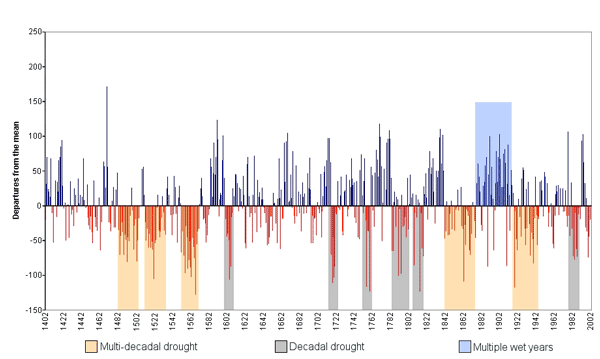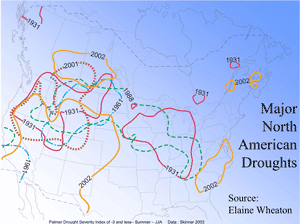Drought
Saskatchewan’s continental climate is characterized by extremes and high variability in temperature and precipitation. In the future variability may even be greater. One of the major threats is drought. Preparing for drought emergencies and adapting to a drier climate is critical for both urban and rural communities, and for forestry and agriculture.
Drought is a period of no or little precipitation relative to normal levels. Drought can limit crop production, increase the fire hazard in both grasslands and forests, and require water restrictions. If the drought persists surface water and stream flows are reduced and groundwater sources may be impacted.
A History of Drought
Drought is a common feature of the prairies and can persist over many years. In Figure 1 drought periods are illustrated by red. Droughts have lasted for decades (grey shading) or longer (orange shading). The climate of the twentieth century was relatively favourable for settlement of the Prairies as it lacked the sustained droughts of proceeding centuries.
Within the Canadian Disaster Database, drought is the most frequent occurrence of extreme event for Saskatchewan. The years of drought impacting on the province are: 1910, 1914, 1917-1921, 1924, 1929, 1931-1939, 1958-1963, 1967-1969, 1974, 1977, 1979-1981, 1983-1986, 1988-1992, 2001-03 and 2009.
The date and extent of major droughts in North America over the past century are illustrated in Figure 2. 2002 was the worst one-year drought on record.
The impacts of drought in 2001 and 2002 were major and across all sectors:
- agricultural production dropped $3.6 B,
- GDP fell $5.8B,
- 41,000 jobs lost,
- negative net farm income for 2002 in Saskatchewan,
- previously reliable water supplies were challenged,
- crop insurance payments in Saskatchewan were $1.431B.
Saskatchewan - A Drier Future
Future climate scenarios indicate that the province will be drier owing largely to increased evapotranspiration from warmer temperatures. Although there will still be wet years, drought years will become more frequent
Adaptation Actions
- Plan for drought preparedness and response by municipalities, resort communities, parks and individuals including farmers and ranchers.
- Improve warning systems (e.g. drought watch).
- Continue with crop insurance and disaster response programs
- Participate in watershed planning.
- Implement water conservation initiatives.
- Establish secure water supplies that will be available during drought (develop new sources, new infrastructure).
- Adopt dry-land farming techniques (zero till, perennial forage), seed drought-resistant crops and varieties.
- Investigate feasibility of irrigation in light of water availability and other water demands.
Sources:
- Agriculture and Agri-food Canada (n.d.): Lessons Learned from the Canadian Drought Years 2001 and 2002 Synthesis Report http://www4.agr.gc.ca/AAFC-AAC/display-afficher.do?id=1256667063661⟨=eng
- Barrow, E. (2009): Climate Scenarios for Saskatchewan. PARC Summary Document No. 09-01, 15 p.
- Environment Canada (n.d.): Canada’s Top Ten Weather Stories Archive. http://www.ec.gc.ca/meteo-weather/default.asp?lang=En&n=3318B51C-1 [accessed March 12, 2011]
- Environment Canada (n.d.): Drought. Atmospheric Hazards Northern and Prairie Region http://pnr.hazards.ca/lightning.html [accessed December 4, 2010]
- Environment Canada (n.d.): Hazardous Weather http://www.ec.gc.ca/meteo-weather/default.asp?lang=En&n=15E59C08-1 [accessed December 4, 2010]
- Public Safety Canada (2010): Canadian Disaster Database http://www.publicsafety.gc.ca/prg/em/cdd/srch-eng.aspx [accessed Februaray 8, 2011]

